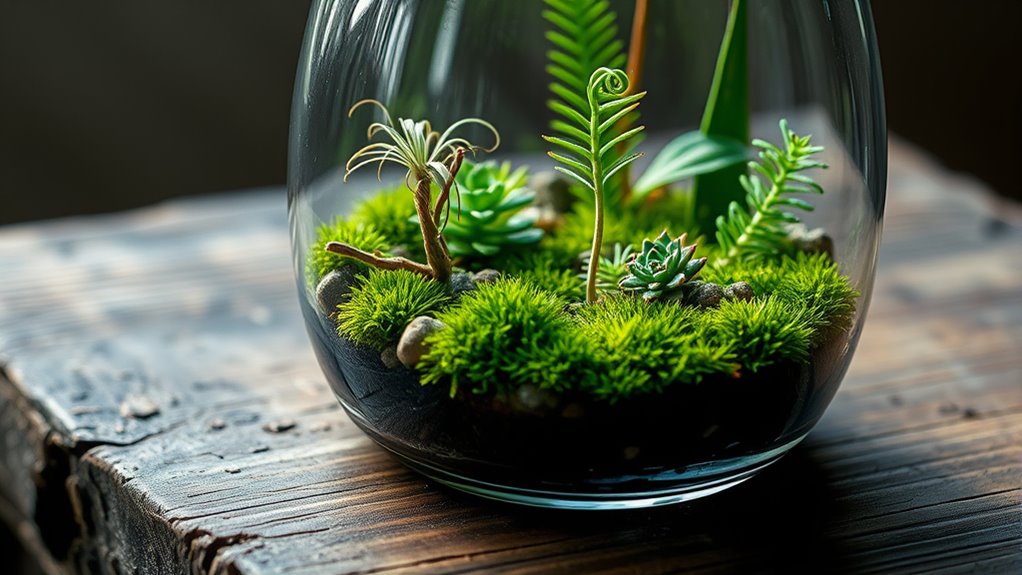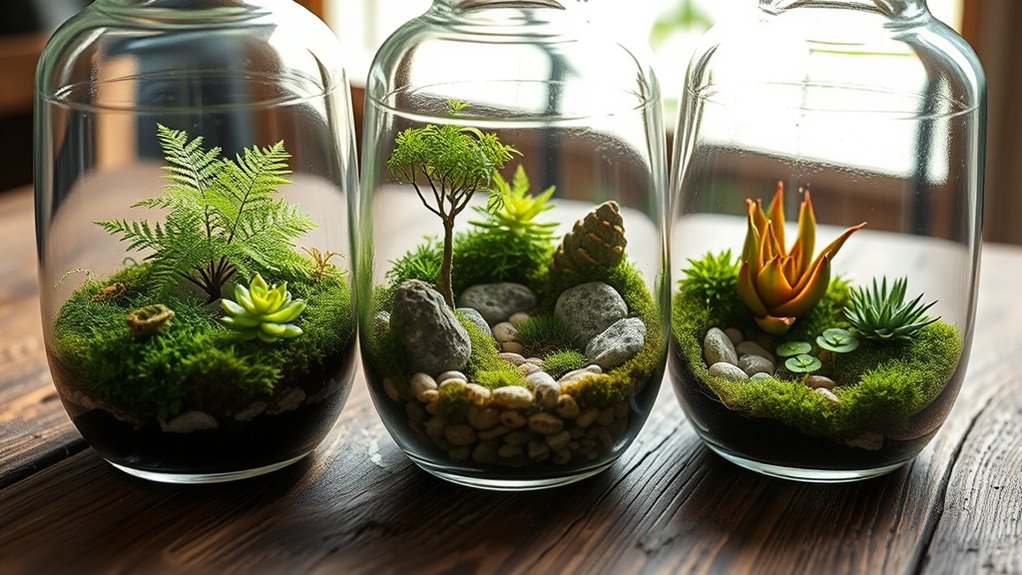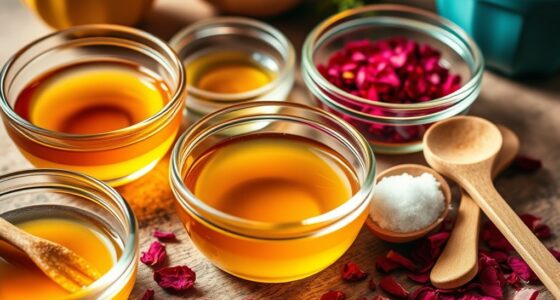To grow your own tiny jungle, choose hardy plants like succulents, mosses, or ferns that thrive indoors, and pick a clear glass container with good drainage. Layer stones, charcoal, and soil before arranging your plants thoughtfully for visual interest. Water lightly and provide the right light for your plants’ needs. With proper care and maintenance, your miniature indoor oasis will thrive. Keep exploring to discover more tips for creating and maintaining your mini jungle.
Key Takeaways
- Select low-maintenance, thriving plants like succulents, mosses, or ferns suited to your lighting conditions.
- Use clear glass containers with drainage layers of stones and activated charcoal for a healthy environment.
- Assemble the terrarium with tailored soil, arrange plants thoughtfully for visual interest, and water lightly.
- Provide appropriate light, prune regularly, and monitor watering to keep your tiny jungle vibrant.
- Maintain cleanliness and rearrange plants as needed to create a balanced, calming miniature indoor ecosystem.

Creating your own terrarium is a rewarding way to bring a touch of nature indoors and customize your space. The first step in this process is choosing the right plant selection. You want plants that thrive in enclosed environments, so opt for varieties like succulents, air plants, mosses, or small ferns. These plants are hardy, require minimal maintenance, and add diverse textures and colors to your tiny jungle. Consider how much light your space gets; for bright spots, succulents and cacti are ideal, whereas low-light areas benefit from moss or ferns. Think about the growth habits of your plants too—selecting a mix of tall, trailing, and compact plants creates visual interest and balance within your terrarium.
Next, focus on container styles. The container not only holds your mini ecosystem but also influences its overall aesthetic. You can choose from glass jars, aquariums, old jars, or specially designed terrarium containers. Clear glass is popular because it allows you to see the layers and appreciate your plants from all angles, while textured or colored containers add a unique flair. Consider size and shape based on your space and the plants you’ve selected. For example, a tall, narrow vessel suits climbing or trailing plants, while a wide, shallow dish works well for mosses and succulents. Make sure your container has drainage options—adding a layer of small stones or gravel at the bottom prevents excess water from sitting around the roots, reducing the risk of rot.
When assembling your terrarium, start with the drainage layer, then add activated charcoal to keep the environment fresh and prevent odors. Follow with your soil mix tailored to your plant choices—cactus mix for succulents or potting soil for ferns and moss. Plant your selection with care, creating a layout that balances height, color, and texture. Adjust the placement as you go, ensuring each plant has enough room to grow. Once everything is in place, lightly water your plants, being mindful not to overdo it. Incorporating proper care techniques ensures your tiny jungle remains healthy and vibrant over time.
Maintaining your tiny jungle is straightforward once you get the hang of it. Keep an eye on the light and watering needs, trimming back overgrown plants to keep the layout tidy. With thoughtful plant selection and attention to container styles, you’re well on your way to creating a stunning, miniature indoor landscape that brings greenery and tranquility into your daily life.
Frequently Asked Questions
What Are the Best Plants for Beginner Terrariums?
When choosing plants for beginner terrariums, focus on animal-friendly plants and low-maintenance greenery. You should consider succulents like jade or aloe, which thrive with minimal watering, or air plants that don’t need soil. Ferns and mosses are also great for humid environments. These options are easy to care for, making them perfect for beginners who want a beautiful, low-effort terrarium that’s safe for pets.
How Often Should I Water My Terrarium?
You should water your terrarium based on its moisture levels, not on a set schedule. Check the soil regularly—if it feels dry a finger’s depth deep, it’s time to water. Typically, watering once every 2-4 weeks works well for most terrariums, but monitor closely, especially in dry or humid environments. This watering schedule helps maintain the right moisture levels and keeps your plants healthy.
Can I Use Any Container for a Terrarium?
You can use many container options for your terrarium, but consider material considerations first. Glass containers work best because they allow light in and are easy to clean. Avoid containers that aren’t airtight or have sharp edges, which could harm your plants. Make sure your container has drainage or plan to add a layer of gravel. Ultimately, choose a container that’s clear, stable, and suits your plant’s needs.
How Do I Prevent Mold Growth Inside My Terrarium?
Minimize mold menace by mastering moisture management! To prevent mold growth inside your terrarium, regularly monitor humidity levels and avoid overwatering. Use a well-ventilated container, and consider adding activated charcoal to absorb excess moisture and toxins. Keep the environment dry and airy, and remove any moldy or decaying debris immediately. By balancing humidity control and practicing proper mold prevention techniques, you’ll keep your miniature jungle healthy and thriving.
Are There Sustainable or Eco-Friendly Materials for DIY Terrariums?
You can make your DIY terrarium more eco-friendly by choosing sustainable materials. Recycled glass or plastic bottles serve as excellent containers, reducing waste. Opt for biodegradable options like bamboo or cork for accents or decorations. These materials break down naturally, minimizing environmental impact. By selecting recycled and biodegradable items, you help protect the planet while creating a beautiful, sustainable miniature jungle inside your terrarium.
Conclusion
Creating your own tiny jungle might seem intimidating at first, but with a little patience, you’ll find it surprisingly simple and rewarding. Plus, it’s a stylish way to bring nature indoors without the hassle of traditional gardening. If you’re worried about maintenance, remember that terrariums thrive in low light and require minimal watering, making them perfect even for busy schedules. So go ahead—start your mini jungle today and enjoy a lush, living masterpiece in your own space.









